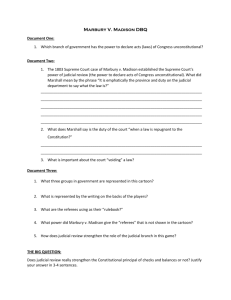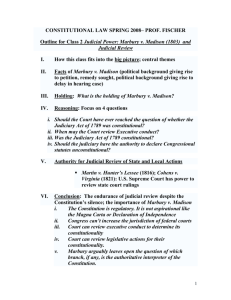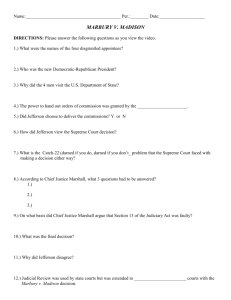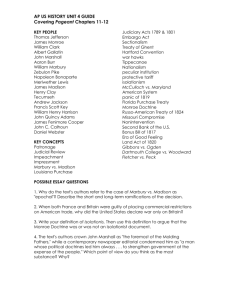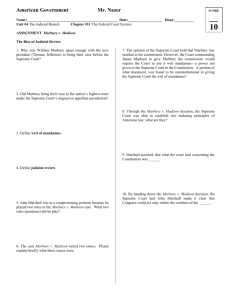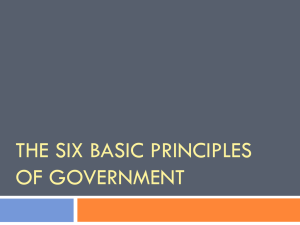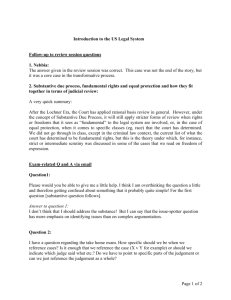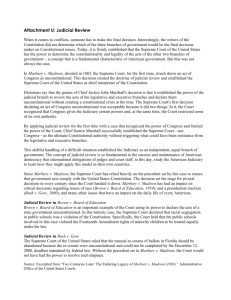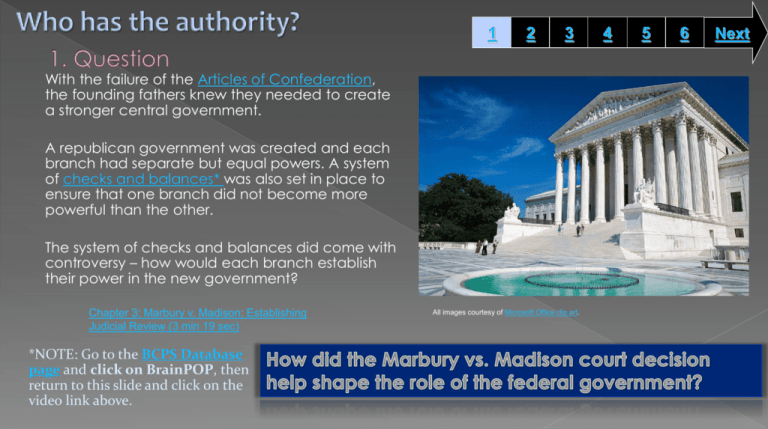
1
2
3
With the failure of the Articles of Confederation,
the founding fathers knew they needed to create
a stronger central government.
A republican government was created and each
branch had separate but equal powers. A system
of checks and balances* was also set in place to
ensure that one branch did not become more
powerful than the other.
The system of checks and balances did come with
controversy – how would each branch establish
their power in the new government?
Chapter 3: Marbury v. Madison: Establishing
Judicial Review (3 min 19 sec)
*NOTE: Go to the BCPS Database
page and click on BrainPOP, then
return to this slide and click on the
video link above.
All images courtesy of Microsoft Office clip art.
4
5
6
Next
1
2
3
4
5
6
Next
It was easy for the President and the Congress to
establish their power – their power was explicitly stated
in the Constitution. However, the Supreme Court did
not have explicitly stated powers.
How did the Supreme Court establish its separate but
equal power in the federal government?
1. Read and or watch the following digital resources to review the
role of the Judicial Branch:
›
Overview of the Supreme Court*
›
World Book Student: Judicial Review
›
Student Resources in Context: Judiciary Act of 1789
*NOTE: Go to the BCPS Database page
and click on BrainPOP, then return to this
slide and click on the video link to the left.
2. Research the Marbury vs. Madison court case:
›
World Book Student: Marbury vs. Madison
›
Street Law: Marbury vs Madison chart
›
Our documents: Marbury vs Madison background
›
Our documents: Marbury vs. Madison court decision
Task: Complete the graphic organizer based on your research.
Readability:
Help me understand! =
I can get it on my own =
Challenge me! =
1
In 1800, Thomas Jefferson was
elected the 3rd president of the
United States. The previous
president, John Adams, appointed
judges before he left office, which
caused a huge controversy.
Use the graphic organizer you
created while researching the
Marbury vs. Madison court case,
complete the understanding
checkpoint to demonstrate your
general understanding of the
court case.
›
You do not need to save the document, but
you may want to keep it open to help you with
the assessment activity!
2
3
4
5
6
Next
1
2
3
4
5
6
Use both the graphic organizer and the
understanding checkpoint activity to
help you create a written response to
our enduring knowledge question from
the beginning of the lesson:
Create a written response using the 6+1
writing traits as a guide.
› Open the document and respond to
the question
*Refer to the scoring tool to help you
construct your response. (BCPS Office of Social
Studies)
*Don’t believe that this case is important?
Check this out!
Next
1
*http://law2.umkc.edu/fac
ulty/projects/ftrials/conla
w/satire.htm
2
3
4
5
6
Next
Information Literacy Skill/Process:
How can we tell if we’re visiting a credible website?
1.
Check the website address – is it from a non-profit
organization (.org), a for profit company (.com), or a
government agency (.gov).
2.
Does the website have an “About us” section to
explain who the publishers are? Can you contact the
publishers at a mailing address and phone number as
well as an email address?
3.
Is there a last date of publication/update to the
website?
4.
Are there advertisements on the page?
"Do you ever have one of those days when everything seems
unconstitutional?"
Check the sources we’ve used in this activity to determine
the credibility of the websites.
Additional content
1. Take a virtual tour of the Supreme Court building in Washington DC. How do the
justices conduct their business?
2. The Supreme Court’s right to judicial review has ruled in support of the rights of
individuals. Read these cases and determine how the judicial review helps to secure
the rights of the citizens of the USA. (BCPS Office of Social Studies)
1
BCPS Curriculum
Unit VI – Indicator D.2 Students will analyze the impact that Marbury vs. Madison had on the federal judiciary in order to
determine the degree to which it represented continuity or change in the American culture.
Maryland State Curriculum
Standard 1.C.1.c Explain the significance of the landmark U.S. Supreme Court case Marbury v. Madison which established
judicial review.
Common Core State Standards – Social Studies (6-8)
RH.6-8.1. Cite specific textual evidence to support analysis of primary and secondary sources.
RH.6-8.2. Determine the central ideas or information of a primary or secondary source; provide an accurate summary of
the source distinct from prior knowledge or opinions.
RH.6-8.3. Identify key steps in a text’s description of a process related to history/social studies (e.g., how a bill becomes
law, how interest rates are raised or lowered).
RH.6-8.7. Integrate visual information (e.g., in charts, graphs, photographs, videos, or maps) with other information in print
and digital texts.
WHST.6-8.2. Write informative/explanatory texts, including the narration of historical events, scientific procedures/
experiments, or technical processes.
WHST.6-8.7. Conduct short research projects to answer a question (including a self-generated question), drawing on
several sources and generating additional related, focused questions that allow for multiple avenues of exploration.
Standards for the 21st Century Learner
1.1.6 Read, view, and listen for information presented in any format (e.g. textual, visual, media, digital) in order to make
inferences and gather meaning.
2.1.3 Use strategies to draw conclusions from information and apply knowledge to curricular areas, real-world situations,
and further investigations.
Maryland Technology Literacy Standards for Students
3.0 : Use a variety of technologies for learning and collaboration.
2
3
4
5
6
Time Frame: 2- 45 minute class periods
Differentiation:
Databases provided have text features to
assist in reading (audio read-aloud,
embedded dictionaries)
BrainPop includes closed captioning for
student to follow along
Learning Styles:
Field Dependent, Field Independent, Visual,
Auditory, Tactile, Reflective, Global
AVID Strategies:
inquiry based learning, 6+1 writing traits,
composition tool
Notes to the teacher:
Consult with your School Library Media
Specialist to implement this Slam Dunk Lesson.
Students can turn in activities by saving
Microsoft documents and copying it to your
school’s student drive(directions on each
worksheet)
Safari Montage clip on slide 1 should be
shown to entire class. A login is required and
the movie title is called “The Judicial Branch”.
Remove the following links before
implementing this Slam Dunk lesson: Answer
key
Last update: July 2015
Created by Jamie Higgins Shaull , Social Studies Department Chair, General John Stricker Middle School
BCPS Research Module or Slam Dunk Model, Copyright 2005, Baltimore County Public Schools, MD, all rights reserved. The models may be used for educational, non-profit school use
only. All other uses, transmissions, and duplications are prohibited unless permission is granted expressly. This lesson is based on Jamie McKenzie’s Slam Dunk Lesson module available
at http://fno.org/sept02/slamdunk.html

